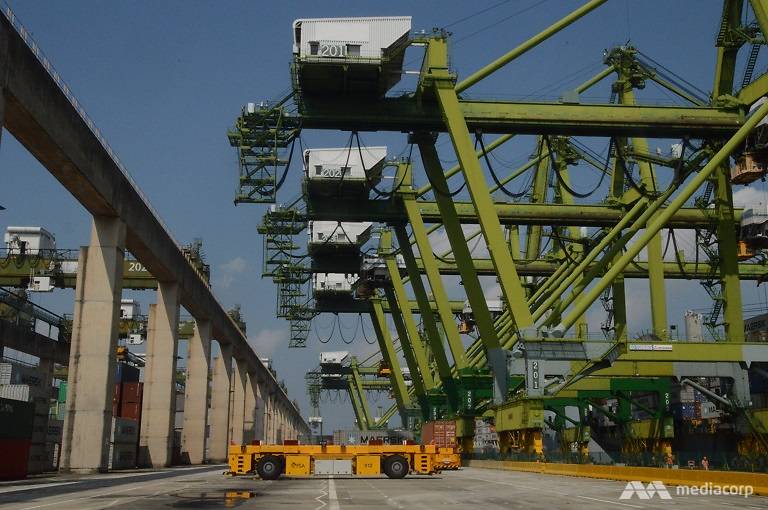SINGAPORE: Automated quay cranes are currently on trial at the Pasir Panjang Terminal to enhance efficiency of operations and improve working conditions for workers, Singapore port operator PSA said on Monday (Jul 23).
The automated quay crane (AQC) system moves containers from vessels that are berthed at Pasir Panjang Terminal onto prime movers. These cranes are unmanned at the site and are monitored remotely from a control centre.
Transport Minister Khaw Boon Wan was given a tour around the terminal on Monday morning, where he was briefed by PSA staff on how the AQC has helped operations.
Minister Khaw Boon Wan being breifed on how the automated quay crane (AQC) system works. (Photo: AMir Yusof)
PSA said there are currently three AQCs on trial. The cranes were purchased from Chinese equipment manufacturing company ZPMC.
PSA said it is aiming for the AQCs to be fully operational when the Tuas mega port is completed in 2040.
At Tuas, the AQCs will be complemented by automated guided vehicles (AGVs), self-driving machines that facilitate movement of shipments at the port. The AQCs will transfer containers to the AGVs
The containers picked up by the AQC from vessels will be transferred to the self-driving AGVs, to allow for efficient transportation of goods without the need for any operator or engineer to be physically present.
The AGVs load up cargo picked up by cranes and transport it around the port. (Photo: Amir Yusof)
Pasir Panjang Terminal has 30 AGVs being trialled – eight of which are hybrid while 22 are fully battery operated. The vehicles are being used to transport containers from overhead bridge cranes, which are semi-automated.
Mr Eddy Ng, managing director of PSA Singapore, said that one key challenge faced by the company is in preparing its staff to operate the AQC. PSA currently has around 200 operators who can handle AQCs and the company plans to eventually train all of its 500-600 operators to be able to use it.
The mechanical cranes currently being used require operators to be stationed on the crane itself, working in a booth which is 17 storeys high, while operators for the AQCs are stationed in a remote air-conditioned office.
Mr Lee Poh Ann, a container equipment specialist who has worked at PSA for 25 years, told media that he was initially not confident of operating the AQC, but became proficient after guidance from his instructor.
“Working in the office is better because we can enjoy the air-conditioning and comfort,” he said with a chuckle.

30 AGVs at Pasir Panjang Terminal are being used to transport containers from over head bridge cranes. (Photo: Amir Yusof)
Additionally, Mr Ng also highlighted that some ships still do not have the tools that are compatible with automation.
“One example of a challenge we face is the (securing) of containers onboard ships. This represents a key challenge because the tools are mechanised tools and yet to be subjected to automation and technology,” Mr Ng said.




